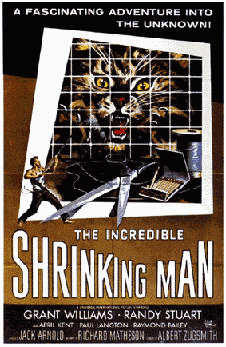  |
| This Island Earth (1955)
| This was a big budget space opera when it first came out. The special effects are state-of-the-art by 1955 standards and the Metaluna mutant with its shaved-scrotum head and lobster claws remains a powerful iconic image in SF. The plot is fairly lame when examined. The wussy-boy Metalunans (led by Jeff Morrow) attempt to brain-drain the Earth, using brilliant scientists to help their own version of the arms race. Their war effort against the Zahgons isn't going well. The never-seen baddies have been dropping meteors on Metalua until it begins to look like a char-grilled bath sponge. The rock-jawed engineer Cal Meachum (Rex Reason) and coy lad scientist (Faith Domergue) get there too late to help, a fear-crazed mutant tries to kill them all, they head back to the Earth and the spaceship crash lands after the humans fly off in their captured Cessna. The interocitor, an alien machine which is constructed as a part of their I.Q. test for scientists is cool, too. Kind of like a videophone with a built-in particle accelerator. Just the thing for obscene video calls.
Not as good as The Incredible Shrinking Man, but Glen Langan's performance in the title role is much better than I expected it to be. As usual, a nuclear blast is the villain of the piece, being to the fifties what corporate greed is to such movies in the '80s and '90s. The poor titular bloke grows big, goes mad and starts stomping off across the Nevada desert, which at the time was full of giant spiders, ants, grasshoppers, ambulatory minerals, one-eyed monsters, radioactive Mickey Rooneys, blue books-full of UFOs and thirty-foot brides from Candy Rock. In the climax, he's shot and falls off Hoover Dam in a scene which was blatantly stolen by Harrison Ford in The Fugitive thirty-six years later. (The U.S. Army had the Tommy Lee Jones role in Colossal Man). |
| The Incredible Shrinking Man (1957) |

| This is one of the lost gems. I just picked it up at the video shop, having not seen it for twenty years and I still love it. Richard Matheson's script, based on his own novel, is flawlessly internally-consistent and hits all the right buttons with a subtle finger.
Scott Carey (Grant Williams) is laying on the foredeck of his brother's boat when a radioactive cloud passes over him. Four months later he's accidentally sprayed with pesticide. Two months later, he finds that he's shrinking. At that point his fate is sealed. No fudges, no deux ex machina hokum ending. No cop-out. |
| At first Carey's condition is treated like a medical one. Change a little of the dialogue and skip the special effects and you could be seeing a film about a cancer victim or the first person in the world to acquire HIV. Jack Arnold, the director (who also directed The Creature from the Black Lagoon), plays it like a standard family crisis. Carey's trousers and shirts are a little too large, he's losing a bit of weight. Could be anything. The quacks run tests, confirm the hypothesis, give a prognosis.
The film then cuts to a scene where Carey's brother is discussing Scott's financial problems with him. Business is bad, so the brother/employer can't support him any more. Cut to Carey, child-sized in a large armchair. The buttons on his shirt are slightly enlarged to give verisimiltude to the scene. Carey has become small not only physically but financially. In a boom period like the '50s, an inability to make a buck must've been scary. Come to think of it, same goes for the '90s. |
| At this time, there's a remission in his disease thanks to a serum developed by his doctors. But he's told he may never grow again, and this triggers a deeper depression. As his marriage dissolves in all but name, he forms a brief relationship with a circus midget, but flees when he realises one day that she's suddenly taller than him. Remission is over. |
| Like all good SF, The Incredible Shrinking Man works on several levels… |
| The second half of the film changes tone completely. From a freak trying to hang on to dignity in a 20th Century world, Carey is thrust into a neolithic existence as he accidentally falls into the basement of his house. His wife and brother think the cat has eaten him - and to give the cat it's due, it tried to. The now-elephantine feline toys with Carey like a mouse, a small epiphany occurs for our protagonist.
He starts to use his mind to survive, clicking into a different mode of existence in a manner reminiscent of Cornel Wilde fleeing the African warriors in The Naked Prey. In the basement, Carey's problems are more immediate than merely being a freak in a human world. Food, drink and safety. | ||
| Without spoiling the film, I'll say that he does overcome all obstacles and comes to terms with his condition and accepts his new nature and the fact that he's both human and something other than a man as he dwindles from sight, but not from mind.
Like all good SF, The Incredible Shrinking Man works on several levels, which I'll leave you to discover for yourselves. I can only think of one other movie in which the protagonist undergoes such a profound change and that's a more recent flick called Candyman in which Virginia Madsen's heroine is utterly transformed by her encounters with the eponymous evil spirit. But the real theme in Shrinking Man is that it's about the impact of the inexplicable on an individual. It's the thinking fan's 1950s SF film to see. |
| The Fly (1958) |
| James Clavell wrote the screenplay for this one, based on a George Langelaan short story. A scientist has had his head and arm strawberry-jammed under a hydraulic press and the investigation leads Vincent Price and Herbert Marshall into the well-known tale of matter-transference gone wrong. |
| It's very different from the Cronenberg version but the plot is well constructed, the acting is strong and effective and the bit where the kitten disappears into limbo is genuinely disturbing. I find that I have trouble with Price in a sympathetic role. I keep expecting him to put the hard word on his widowed sister-in-law, but he doesn't. The film's score, by Paul Sawtell, is probably the most perfect example of fifties SF soundtrack. Lots of strident strings and punctuating brass. |
Continuing in May, 1997: The 1960s - From
Chicks to Cybernetics
|
Like us on facebook |
No other uses are permitted without the prior written consent of owner. Use of the material in violation of the foregoing may result in civil and/or criminal penalties. Celebrate everything! www.festivale.info ISSN 1328-8008 Published in Melbourne, Victoria, Australia disclaimers | contact the editor | Festivale revision history  Published in Melbourne, Victoria, Australia Published in Melbourne, Victoria, Australia  copyright © Festivale 1999 All rights reserved copyright © Festivale 1999 All rights reservedFiled: 24-Mar-1997 Entire site refreshed: Dec 2008-Feb 2009 | Site URL transferred: Jan 2005 (previously www.festivale.webcentral.com.au) |



